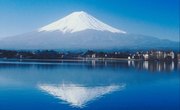
Volcanoes are one of nature’s most destructive forces. However, volcanoes are also one of nature’s chief constructive forces. Volcanic eruptions are responsible for creating new crust and geological landforms. The specific results of a volcanic eruption differ widely; each volcano type has a distinct eruptive nature.
Shield Volcano Eruptions
Shield volcanoes are formed by layers of very fluid basaltic lava, which tends to flow long distances before solidifying. As a result, shield volcano eruptions create large, broad plateaus with gently sloping sides that resemble a shield. These eruptions lack the explosive nature of other volcano types, producing longer eruptions of lava fountains. Shield volcano lava flows can cover large areas of land -- their most destructive effect. The long-term result of these eruptions is the formation of islands, such as the Hawaiian Islands, and lava fields.
Composite Volcano Eruptions
Composite volcanoes can erupt with explosive results. The reason is that their andesite lava is cooler and much thicker than basalt lava, allowing them to capture large quantities of gas. These gas pockets create massive explosions when the volcano erupts, like popping the cork on a bottle of champagne. These volcanoes also produce pyroclastic flows. These billowing clouds of superheated gasses and particles can travel great distances at high speeds, destroying everything they come in contact with. Composite eruptions typically include massive eruption plumes that pump large quantities of gases, such as sulfur, and tiny particles into the atmosphere. This can impede air travel and lead to drops in global temperatures.
Cinder Cone Volcano Eruptions
Cinder cone volcano eruptions are like a hybrid between a shield and composite eruption, though the characteristics are more similar to the shield volcano. Like a shield volcano, cinder cone volcanoes feature basaltic lava. However, their lava is slightly thicker. This allows for the trapping of some gases. Typically, these eruptions eject small clumps of lava, called bombs, which solidify before they rain down on the surface. This creates a pile of cinder like volcanic rock around the vent. These volcanoes are normally very small, and only present a danger to the immediate area.
Caldera Volcano Eruptions
Caldera volcanoes are fueled by geological hot spots, such as the Yellowstone supervolcano complex in North America. Caldera volcanoes are composed of the thickest, most explosive magma, created from melted continental crust. Such volcanoes produce cataclysmic eruptions that destroy large areas and impact the entire globe. The last Yellowstone eruption, around 600,000 years ago, ejected more than 240 cubic miles of material into the atmosphere.
References
About the Author
Doug Bennett has been researching and writing nonfiction works for more than 20 years. His books have been distributed worldwide and his articles have been featured in numerous websites, newspapers and regional publications. Bennett's background includes experience in law enforcement, the military, sound reinforcement and vehicle repair/maintenance.
Photo Credits
Thinkstock/Comstock/Getty Images
